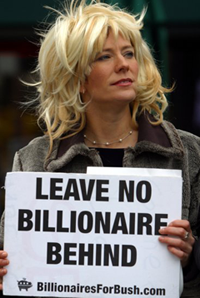
- Richistan: A Journey through the American Wealth Boom and the Lives of the New Rich
- Crown (2007)
Scott Fitzgerald was wrong: the rich are just like you and me.
No matter how much money they have, they'd feel more secure with twice as much. They tend to spend more than they make. They have trouble teaching their kids the value of a dollar. They even need support from peer groups.
So says Robert Frank, who for years has covered the "wealth beat" for the Wall Street Journal. Now he's published Richistan, about the lives and influence of America's very, very wealthy. Their lives are largely banal, but their influence is considerable -- and not always what we might think.
Frank approaches the Richistanis as a distinct nation. They aren't really living with ordinary Americans, physically or culturally. But most are émigrés from America's middle class, the wealthiest parvenus in history. They are both a recent phenomenon and a familiar one: Frank sees them as the "Third Wave" of dramatic wealth-building, after the Gilded Age (1865-1890) and the Roaring Twenties (1918-1929). In those eras, the top one percent of Americans held almost half the nation's wealth.
But after the Depression and Second World War, wealth began to reach ordinary Americans. By 1975, the top one per cent could claim only 20 per cent of all American wealth. Those were the days when a one-income working family could support a stay-at-home spouse, buy a home and send the kids to college.
Doubling the number of millionaires
Ronald Reagan changed all that. By 1989, Frank says, the top one per cent held 30 per cent of U.S. wealth, and their share is now 33 per cent.
But the Third Wave has created far more Richistanis than the earlier eras. "Half of America's total wealth has been created over the past 10 years," Frank says. North Carolina alone has as many millionaires as all of India -- about 83,000. Between 1995 and 2003, the number of American millionaire households doubled to over 8 million.
Most of this wealth is not thanks to inheritance. It's from "liquidity events," when an entrepreneur sells his company or takes it public. The resulting gusher of cash creates instant millionaires or even billionaires: the founder, the senior executives and early hires, the money movers, and some of the CEOs.
Today's Richistanis have redefined the meaning of wealth. Any West Vancouver homeowner might end up a millionaire just by selling his house, but a million bucks is chump change now. In the States, that would put you in Lower Richistan, a vulgar mob of 7 million households where the average cost of a wristwatch is $2,100.
To get away from the riffraff, you need $10 million to $100 million, which puts you in Middle Richistan. Only 2 million Americans fall into this bracket; they think $71,000 is a reasonable price for a wristwatch.
Welcome to Billionaireville
Upper Richistanis, worth $100 million to $1 billion, total just a few thousand. These folks will pay $182,000 for a wristwatch. Billionaireville, by contrast, had 13 residents in 1985 and 400 in 2006. They can hire a consulting firm to tell them what time it is.
Frank has managed to meet many Richistanis, learning how they made their money and what they do with it. The book is a series of gossipy chapters laced with statistics -- very much like supermarket tabloid papers' accounts of who's fat, who's anorexic and who's sleeping with whom.
But Robert Frank isn't interested just in unlikely success stories or heartbreaking anecdotes about those who made and lost a fortune. Like an anthropologist trying to understand the potlatch, he examines the status displays of Palm Beach "charity" balls, where the point is not to improve the life of the poor but to win status by giving more than the next Richistani.
Others gain status by building ever larger yachts: to be in the running these days, your boat needs to be over 500 feet long, cost over $200 million, and offer at least two helipads: one for your own helicopter, and the other for your guests'.
The rise of plutonomics
Richistanis compete for a relatively small number of consumer goods, so they face higher inflation rates than the rest of us. But they spend so much that billions really do trickle down. Frank calls the process "plutonomics." He suggests that Richistani consumer spending has helped keep the U.S. economy strong -- though at a literally high price:
"Despite their huge new fortunes, many of today's millionaires -- and even billionaires -- are living beyond their means. The nation's richest one per cent took on $383 billion in debt between 1995 and 2004, most of it in the form of mortgages and instalment debt. Their debt grew 235 per cent between 1989 and 2004, while their total wealth grew at half that rate."
Meanwhile, the very conspicuous consumption of the Richistanis is driving ordinary Americans to try to keep up. Maybe they can't afford $2,100 wristwatches, but they have certainly learned to live beyond their means.
Some of the very wealthy are thinking beyond mere consumption or hosting white-tie charity balls. Frank admiringly cites some "performance philanthropists" who spend millions on direct, effective aid to people who really need it.
Too rich to be right-wing
He also tells us that single-digit millionaires may be great supporters of George W. Bush, but the really rich tend to be highly liberal -- and politically active. The "super extreme self-financers" who run for office are usually Democrats. Others just pour millions into Democratic campaigns, like the "Gang of Four" who wrested Colorado from Republican control in 2004.
Are the Upper Richistanis just guilty limousine liberals? No, says Frank -- they're so rich they have to take the long view and consider how to spend their money to protect it for generations.
Richistan offers some surprises. Robert Frank describes a Butler Boot Camp whose graduates, as "household managers," will start work at $120,000 a year. He interviews a man who's made a fortune selling scarce and expensive art to instant millionaires who need to put something on the walls of their enormous new mansions. And he meets a stonemason who's served his clients so well he can go shopping for his own Ferrari.
But I wish he had devoted more time to studying the impact of the Richistanis on ordinary Americans. They're not just working harder to keep up with the Gateses and Ellisons; most middle-class households are increasingly stressed and insecure, with dangerous consequences for their health and life expectancy. However well intentioned, Richistani philanthropy can't compensate for what happens to ordinary folks because of the income gap.
Still, this is a readable, informative and insightful look at the biggest group of very rich people the world has ever seen. At some point a new war or depression may cause their government to redistribute Richistani wealth, as Teddy Roosevelt and Franklin Roosevelt did. The middle class may again see a golden age like that from V-J Day to Watergate, while the Richistanis worry about meeting their mortgage payments.
But I don't expect to live to see it.




